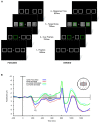Irrelevant stimulus processing in ADHD: catecholamine dynamics and attentional networks
- PMID: 24723897
- PMCID: PMC3972460
- DOI: 10.3389/fpsyg.2014.00183
Irrelevant stimulus processing in ADHD: catecholamine dynamics and attentional networks
Abstract
A cardinal symptom of attention deficit and hyperactivity disorder (ADHD) is a general distractibility where children and adults shift their attentional focus to stimuli that are irrelevant to the ongoing behavior. This has been attributed to a deficit in dopaminergic signaling in cortico-striatal networks that regulate goal-directed behavior. Furthermore, recent imaging evidence points to an impairment of large scale, antagonistic brain networks that normally contribute to attentional engagement and disengagement, such as the task-positive networks and the default mode network (DMN). Related networks are the ventral attentional network (VAN) involved in attentional shifting, and the salience network (SN) related to task expectancy. Here we discuss the tonic-phasic dynamics of catecholaminergic signaling in the brain, and attempt to provide a link between this and the activities of the large-scale cortical networks that regulate behavior. More specifically, we propose that a disbalance of tonic catecholamine levels during task performance produces an emphasis of phasic signaling and increased excitability of the VAN, yielding distractibility symptoms. Likewise, immaturity of the SN may relate to abnormal tonic signaling and an incapacity to build up a proper executive system during task performance. We discuss different lines of evidence including pharmacology, brain imaging and electrophysiology, that are consistent with our proposal. Finally, restoring the pharmacodynamics of catecholaminergic signaling seems crucial to alleviate ADHD symptoms; however, the possibility is open to explore cognitive rehabilitation strategies to top-down modulate network dynamics compensating the pharmacological deficits.
Keywords: CNV; P300; attention; fMRI; ventral attentional network.
Figures






Similar articles
-
Altered intrinsic organisation of brain networks implicated in attentional processes in adult attention-deficit/hyperactivity disorder: a resting-state study of attention, default mode and salience network connectivity.Eur Arch Psychiatry Clin Neurosci. 2016 Jun;266(4):349-57. doi: 10.1007/s00406-015-0630-0. Epub 2015 Aug 11. Eur Arch Psychiatry Clin Neurosci. 2016. PMID: 26260900
-
Aberrant resting-state connectivity of auditory, ventral attention/salience and default-mode networks in adults with attention deficit hyperactivity disorder.Front Neurosci. 2022 Sep 6;16:972730.. doi: 10.3389/fnins.2022.972730. eCollection 2022. Front Neurosci. 2022. PMID: 36148149 Free PMC article.
-
Connectivity supporting attention in children with attention deficit hyperactivity disorder.Neuroimage Clin. 2014 Nov 20;7:68-81. doi: 10.1016/j.nicl.2014.11.011. eCollection 2015. Neuroimage Clin. 2014. PMID: 25610768 Free PMC article.
-
Toward a new understanding of attention-deficit hyperactivity disorder pathophysiology: an important role for prefrontal cortex dysfunction.CNS Drugs. 2009;23 Suppl 1:33-41. doi: 10.2165/00023210-200923000-00005. CNS Drugs. 2009. PMID: 19621976 Review.
-
A Review of the Default Mode Network in Autism Spectrum Disorders and Attention Deficit Hyperactivity Disorder.Brain Connect. 2021 May;11(4):253-263. doi: 10.1089/brain.2020.0865. Epub 2021 Feb 18. Brain Connect. 2021. PMID: 33403915 Free PMC article. Review.
Cited by
-
Brain-computer-interface-based intervention re-normalizes brain functional network topology in children with attention deficit/hyperactivity disorder.Transl Psychiatry. 2018 Aug 10;8(1):149. doi: 10.1038/s41398-018-0213-8. Transl Psychiatry. 2018. PMID: 30097579 Free PMC article. Clinical Trial.
-
Resting-state EEG dynamics help explain differences in response control in ADHD: Insight into electrophysiological mechanisms and sex differences.PLoS One. 2023 Oct 5;18(10):e0277382. doi: 10.1371/journal.pone.0277382. eCollection 2023. PLoS One. 2023. PMID: 37796795 Free PMC article.
-
Common and distinct neural underpinnings of the association between childhood maltreatment and depression and aggressive behavior.BMC Psychiatry. 2025 Jan 17;25(1):43. doi: 10.1186/s12888-025-06485-0. BMC Psychiatry. 2025. PMID: 39825275 Free PMC article.
-
Altered Cervical Vestibular-Evoked Myogenic Potential in Children with Attention Deficit and Hyperactivity Disorder.Front Neurol. 2017 Mar 13;8:90. doi: 10.3389/fneur.2017.00090. eCollection 2017. Front Neurol. 2017. PMID: 28348547 Free PMC article.
-
Lateral prefrontal activity as a compensatory strategy for deficits of cortical processing in Attention Deficit Hyperactivity Disorder.Sci Rep. 2017 Aug 3;7(1):7181. doi: 10.1038/s41598-017-07681-z. Sci Rep. 2017. PMID: 28775285 Free PMC article.
References
-
- Aboitiz F. (2009a). “Dynamics of a neuromodulator: I. The role of dopaminergic signaling in goal-directed behavior,” in From Attention to Goal-Directed Behavior. Neurodynamical, Methodological and Clinical Trends eds Aboitiz F., Cosmelli D. (Berlin: Springer; ) 187–204 10.1007/978-3-540-70573-4_10 - DOI
-
- Aboitiz F. (2009b). “Dynamics of a neuromodulator: II. Dopaminergic balance and cognition,” in From Attention to Goal-Directed Behavior. Neurodynamical, Methodological and Clinical Trends eds Aboitiz F., Cosmelli D. (Berlin: Springer; ) 205–227 10.1007/978-3-540-70573-4_11 - DOI
-
- Aboitiz F., Carrasco X., Castellanos F. X. (2010). “Attention-deficit and disruptive behavior disorders,” in Encyclopaedia of Psychopharmacology ed. Stolerman I. (New York: Springer)
-
- Aboitiz F., Castellanos F. X. (2011). “ADHD, catecholamines and the default mode of brain function. A reassessment of the dopaminergic hypothesis of ADHD,” in Attention Deficit Hyperactivity Disorder vol. 2 eds Evans S., Hoza B. (Kingston, NJ: Civic Research Institute; ) 2-1–2-13
Publication types
Grants and funding
LinkOut - more resources
Full Text Sources
Other Literature Sources
Miscellaneous

